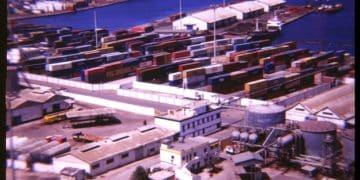Unlock Savings: How to Use FTZs to Cut US Import Duties

Foreign Trade Zones (FTZs) offer a strategic opportunity for US companies to defer, reduce, or even eliminate import duties by allowing goods to be stored, assembled, or processed within the US without formally entering customs territory, providing significant cash flow and competitive advantages.
Navigating the complexities of US import duties can be a significant challenge for businesses, impacting profitability and competitiveness. However, Foreign Trade Zones (FTZs) offer a powerful tool to defer, reduce, or even eliminate these duties, creating substantial financial advantages. Let’s explore how you can leverage FTZs to optimize your import strategies.
Understanding Foreign Trade Zones (FTZs) and Their Benefits
Foreign Trade Zones (FTZs), also known as free trade zones, are secured areas within the United States but legally considered outside the US Customs territory. This unique status allows companies to conduct various activities on foreign goods without being subject to import duties and taxes until those goods enter the US market. Let’s uncover the specific ways FTZs help businesses cut the cost of importing goods.
What is a Foreign Trade Zone (FTZ)?
An FTZ is a designated area within a country that is technically outside of its customs territory. This means that goods can be brought into the zone without being subject to normal import duties or taxes.
Who Manages FTZs?
In the US, FTZs are overseen by the Foreign-Trade Zones Board, and operations are managed by local grantees and operators who ensure compliance with regulations.
- Goods can be stored, tested, sampled, and relabeled in an FTZ.
- Manufacturing and processing activities are also permitted.
- Duties are only paid when goods leave the FTZ and enter the US commerce.

Deferring Import Duties with FTZs
One of the primary benefits of using FTZs is the ability to defer import duties. This means that you don’t have to pay duties on imported goods until they are transferred from the FTZ into the US market. This can significantly improve your cash flow.
Deferring duties can free up capital that would otherwise be tied up in duty payments, allowing you to reinvest in your business.
How Duty Deferral Works
When goods are imported into an FTZ, duties are not immediately imposed. Instead, duties are deferred until the goods leave the FTZ and enter US commerce.
This deferral provides a cash flow advantage, particularly for businesses with long production cycles or those that import large volumes of goods.
- Duties are only paid when the goods leave the FTZ for US consumption.
- If goods are exported from the FTZ, no US duties are ever paid.
- This provides flexibility for businesses that serve both domestic and international markets.
Reducing Import Duties with FTZs
In addition to deferral, FTZs can also help reduce import duties. This can happen in several ways, including through waste reduction and the elimination of duties on re-exports. Let’s dive into how FTZs contribute to lower duty payments.
By effectively managing your operations within an FTZ, you can minimize the amount of duties you ultimately pay.
Waste Reduction
If materials are wasted or scrapped within the FTZ, you may not have to pay duties on those materials. This can be a significant advantage for manufacturers.
Properly managing waste and scrap within the FTZ can lead to noticeable cost savings, especially in industries with high material wastage.
Eliminating Duties on Re-Exports
If you import goods into an FTZ and then re-export them to another country, you don’t have to pay US import duties on those goods. This can make FTZs particularly attractive for businesses engaged in international trade.
Re-exporting goods through an FTZ can streamline operations and reduce overall costs.

Eliminating Import Duties with FTZs
In some cases, FTZs can completely eliminate import duties. This typically occurs when goods are exported from the FTZ or when certain manufacturing processes result in a lower duty rate. Let explore scenarios where duty elimination becomes a reality within FTZs.
Understanding these scenarios will help you take full advantage of the potential cost savings offered by FTZs.
Exporting Goods from the FTZ
As mentioned earlier, goods that are exported from an FTZ are not subject to US import duties. This makes FTZs an excellent option for businesses that import goods for further processing and then export them to other countries.
Exporting through an FTZ allows businesses to remain competitive in the global market by avoiding unnecessary duty payments.
Manufacturing and Duty Rate Inversion
In some cases, manufacturing or processing goods within an FTZ can result in a lower duty rate. This is known as duty rate inversion. This can happen if the finished product has a lower duty rate than the individual components.
Duty rate inversion can provide significant cost savings, particularly for manufacturers who import components for assembly within the FTZ.
Compliance and Regulatory Considerations for FTZs
While FTZs offer significant benefits, it’s important to understand and comply with all relevant regulations. Failing to comply with FTZ regulations can result in penalties and the loss of FTZ privileges. Let’s explore the key compliance and regulatory considerations for operating within an FTZ.
Proper oversight and adherence to regulations are essential for maximizing the benefits of FTZs while avoiding potential pitfalls.
Record Keeping
Accurate and detailed record keeping is essential for FTZ compliance. You must maintain records of all goods entering and leaving the FTZ, as well as any processing or manufacturing activities that occur within the zone.
Security
FTZs are secure areas, and you must implement appropriate security measures to prevent theft or unauthorized access to goods. This may include physical security measures, as well as background checks for employees.
Audits
FTZs are subject to audits by US Customs and Border Protection (CBP). You should be prepared to provide documentation and answer questions about your FTZ operations.
Steps to Setup an FTZ
The process of establishing an FTZ involves several stages, from application to activation, each requiring careful planning and execution. Let’s break down the essential steps to successfully setup an FTZ.
Each step is critical to ensure compliance and maximize the benefits of leveraging FTZs for your business.
Application Process
To establish an FTZ, you must first submit an application to the Foreign-Trade Zones Board. This application will require detailed information about your business, the types of goods you plan to handle in the FTZ, and the potential benefits of the FTZ.
Approval and Activation
Once your application is approved, you will need to work with CBP to activate the FTZ. This involves setting up the necessary security measures and procedures, as well as training your employees on FTZ regulations.
- Secure the physical location and ensure it meets CBP standards.
- Establish proper inventory control and record-keeping systems.
- Train personnel on FTZ operations and compliance requirements.
| Key Point | Brief Description |
|---|---|
| 💰 Duty Deferral | Postpone duty payments until goods enter the US market, improving cash flow. |
| ♻️ Waste Reduction | Avoid duties on materials wasted or scrapped within the FTZ. |
| ✈️ Re-Exports | Eliminate duties on goods imported into the FTZ and then re-exported. |
| 📉 Duty Rate Inversion | Potentially benefit from lower duty rates on finished products compared to components. |
Frequently Asked Questions (FAQs)
▼
The main benefits include duty deferral, reduction, and elimination, improved cash flow, reduced inventory costs, and streamlined logistics for international trade operations.
▼
Duty deferral allows you to delay paying import duties until goods leave the FTZ, freeing up cash that can be reinvested in your business operations or used for other strategic purposes.
▼
Yes, FTZs allow various manufacturing and processing activities, providing opportunities to add value to goods without incurring duties until they enter the US market, or if they are re-exported.
▼
Compliance involves maintaining accurate records of all goods, implementing strict security measures, and preparing for audits by US Customs and Border Protection (CBP) to ensure adherence to regulations.
▼
If goods are imported into an FTZ and then re-exported to another country, you don’t have to pay US import duties on those goods, streamlining international trade and reducing overall costs.
Conclusion
Foreign Trade Zones (FTZs) represent a strategic advantage for businesses seeking to optimize their import strategies and reduce duty-related expenses. By understanding and leveraging the benefits of duty deferral, reduction, and elimination, companies can achieve significant cost savings and improve their overall competitiveness in the global market. The key to success lies in thorough planning, adherence to regulations, and a commitment to maximizing the operational efficiencies that FTZs can provide.





